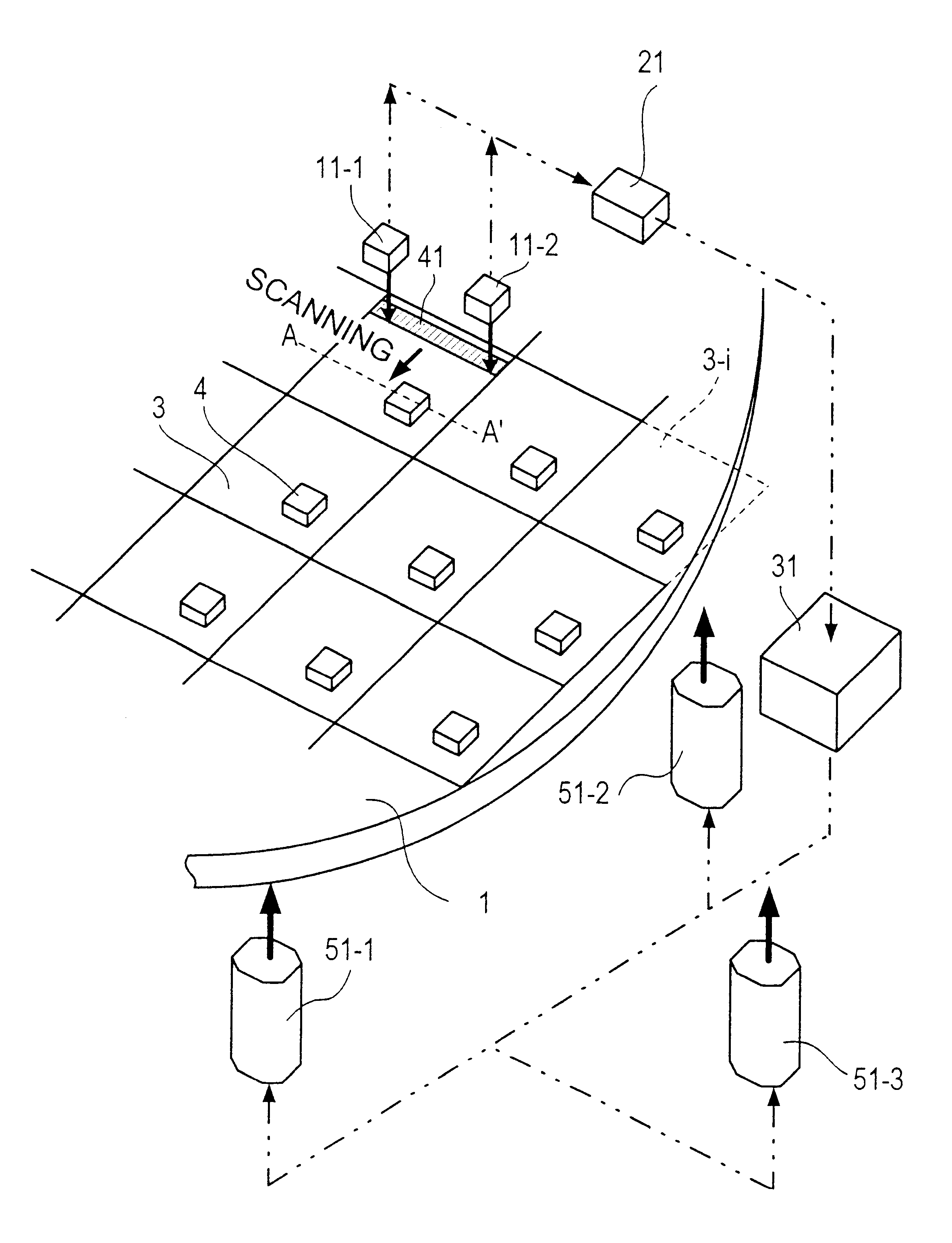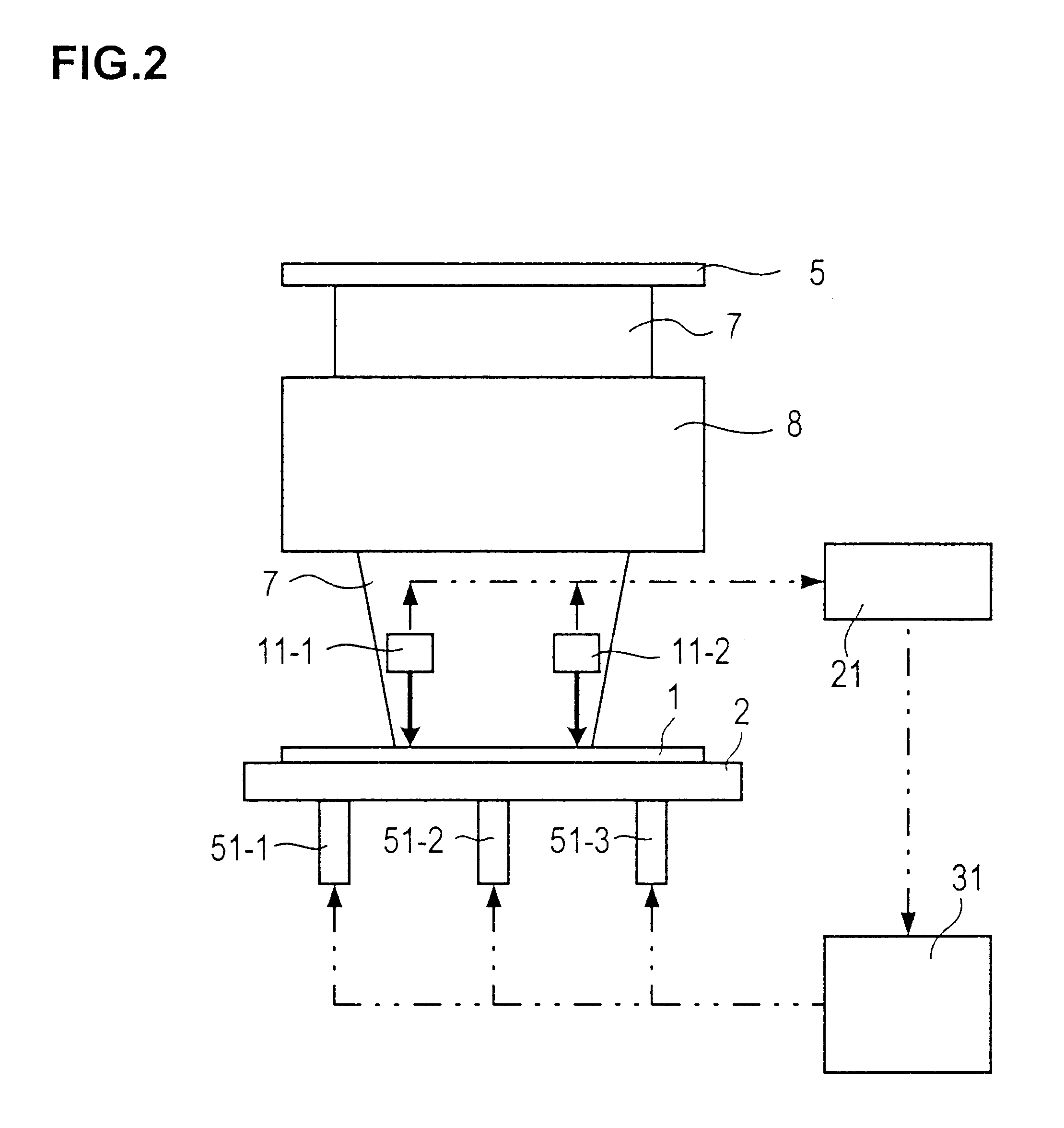Exposure apparatus and exposure method
a technology of exposure apparatus and exposure method, which is applied in the direction of photomechanical equipment, instruments, printing, etc., can solve the problems of poor dimensional accuracy of the transfer pattern, increased likelihood of the exposing light being defocused over a wide range at the surrounding area, and difficult to adopt such a scanning method in the exposure process
- Summary
- Abstract
- Description
- Claims
- Application Information
AI Technical Summary
Benefits of technology
Problems solved by technology
Method used
Image
Examples
first embodiment
(First Embodiment)
The stepper and the exposure method achieved in the first embodiment of the present invention are explained. It is to be noted that the stepper in the embodiment assumes a structure equivalent to that of the stepper shown in FIGS. 1.about.3 except for in the components explained below.
FIG. 5 is a flowchart provided to facilitate an explanation of the individual steps implemented in the exposure method in the embodiment. The following is the explanation of the individual steps taken in the exposure method in the embodiment.
First, the wafer 1 is loaded at the stepper (step S10) and the loaded wafer 1 is then aligned (step S30).
Next, one shot (measurement target unit area) 3-k is selected from the shots 3-1.about.3-n (step S50). At this time, incomplete shots including the shot 3-i are excluded from the selection.
One sensor head, e.g., the sensor head 11-1, is selected from the four sensor heads 11-1, 11-2, 12-1 and 12-2 secured to the exposure slit 9. Utilizing the s...
second embodiment
(Second Embodiment)
Next, the stepper and the exposure method achieved in the second embodiment of the present invention are explained.
The stepper in the second embodiment is provided with a greater number of photosensor heads compared to the stepper achieved in the first embodiment. More specifically, it includes m sensor heads 11-1.about.11-m which are engaged in operation when the scanning operation is performed along direction A and m sensor heads 12-1.about.12-m which are engaged in operation when the scanning operation is performed along direction B, all provided at the exposure slit 9. It is to be noted that the sensor head 11-1 and the sensor head 12-1 are set on a single line extending along the scanning direction, and that the remaining sensor heads a 11-2.about.11-m and sensor heads 12-2.about.12-m respectively achieve the same positional relationship.
FIG. 7 is a flowchart provided to facilitate an explanation of the individual steps implemented in the exposure method in t...
third embodiment
(Third Embodiment)
The stepper and the exposure method achieved in the third embodiment of the present invention are now explained.
As in the stepper in the first embodiment, four sensor heads 11-1, 11-2, 12-1 and 12-2 are provided at the exposure slit 9 in the stepper in the third embodiment. However, as illustrated in FIG. 8, the sensor heads 11-1, 11-2, 12-1 and 12-2 are each capable of moving along a direction perpendicular to the scanning direction.
FIG. 9 is a flowchart provided to facilitate an explanation of the individual steps implemented in the exposure method in the embodiment. The following is the explanation of the individual steps taken in the exposure method in the embodiment.
First, the wafer 1 is loaded at the stepper (step S10) and the loaded wafer 1 is then aligned (step S30).
Next, one shot 3-k is selected from the shots 3-1.about.3-n (step S50). At this time, incomplete shots including the shot 3-i are excluded from the selection.
One sensor head, e.g., the sensor he...
PUM
| Property | Measurement | Unit |
|---|---|---|
| areas | aaaaa | aaaaa |
| area | aaaaa | aaaaa |
| distance | aaaaa | aaaaa |
Abstract
Description
Claims
Application Information
 Login to View More
Login to View More - R&D
- Intellectual Property
- Life Sciences
- Materials
- Tech Scout
- Unparalleled Data Quality
- Higher Quality Content
- 60% Fewer Hallucinations
Browse by: Latest US Patents, China's latest patents, Technical Efficacy Thesaurus, Application Domain, Technology Topic, Popular Technical Reports.
© 2025 PatSnap. All rights reserved.Legal|Privacy policy|Modern Slavery Act Transparency Statement|Sitemap|About US| Contact US: help@patsnap.com



